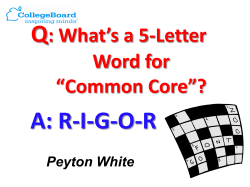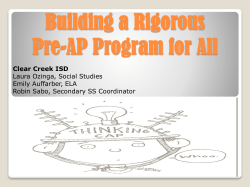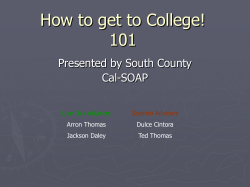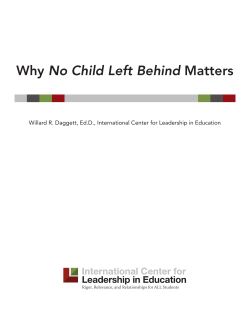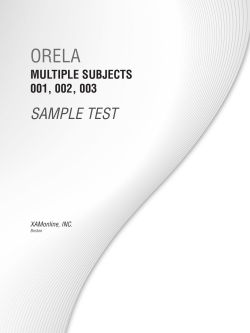
“How to Plan Rigorous Instruction” through the lens of Common Core
“How to Plan Rigorous Instruction” through the lens of Common Core BOOK BY ROBYN R. JACKSON “TELL ME AND I’LL FORGET; SHOW ME AND I MAY REMEMBER; INVOLVE ME AND I WILL UNDERSTAND.” ~CHINESE PROVERB HTTP://MINDSTEPSINC.COM/RIGOR/ What Does Rigorous Instruction Look Like? Rigor goes beyond what student will know and be able to do! (basic memorization and skill proficiency) Rigorous instruction ask students to… Create their own meaning Integrate skills into actual processes Use what they learn to solve real world problems Goes beyond surface understanding Becoming comfortable with being uncomfortable Learning the correct answer is not always clear, and that is okay Fosters students ability to think and learn for themselves THINK ABOUT THIS… HOW MIGHT PLANNING WITH RIGOR IN MIND, CHANGE THE WAY YOU PLAN OR THE WAY YOU THINK WHEN PLANNING? MYTHS ABOUT RIGOR Rigor… Mean more work Work is harder If standards are rigorous, you have rigor Younger students cannot participate in rigorous learning Is only possible after students have mastered the basics Is only for gifted students “BEGIN WITH THE END IN MIND” Common Core Team Planning – We are going to practice using a rigorous summative assessment to plan backwards This will help us…Create Focus, Direction, and Clarity Steps to achieve this… Clarify learning goals (standards, unpacking docs) Decide what we want students to learn (goal) Create clear guidelines as to what mastery looks like Monitor and support student progress toward mastery RIGOROUS ASSESSMENT Measures thinking skills rather than recalling facts Elaborate Make inferences Analyze and construct relationships Defend their judgment Lets students demonstrate their thinking process Think about and use what they learned, answer the how and why Apply what they have learned to real-world or unpredictable situations EXAMPLE On the show “Iron Chef” They are given ingredients and have to build a meal. They are not following a recipe, they have to know how to cook. They have to know how apply their knowledge and adapt to new situations. EXAMPLE - Social Studies Unit How is food grown, packages, and delivered to the grocery store. Traditional Assessment – Create a diagram of the food supply chain Rigorous Assessment – Create a poster that traces a food item (ex. chicken egg) from the farm all the way to the market, then present poster to the class ASSESSMENT “In Traditional Assessment students demonstrate mastery. In Rigorous Assessment, students need to know how to think.” THINK ABOUT THIS Springing surprises on students during an assessment is unfair, IF we don’t properly prepare them But if we provide rigorous instruction involving unpredictable situations all along, then they will be prepared for that rigorous assessment It’s all about getting students to think in a different way, to challenge themselves with the teacher just acting as a tour guide on the road to mastery STEPS WE NEED TO TAKE Step 1 - Think about the kind of thinking you want the student to do Step 2 - Select a summative task that requires students to demonstrate that thinking project, multi-media presentation, create a model, ad campaign, portfolio, speech, debate Step 3 - Determine what you consider mastery (make sure to consider top level and the baseline) Step 4 - Determine how you will grade the assessment (point system, rubric–share ahead of time) ONE WAY TO DETERMINE ASSESSMENT Go back to your essential question and look at how a student might answer it. Example – Essential Question “How can we find themes across multiple texts?” Ask students to read 3 poems, identify the themes, and write about how the themes were different for each poem. Give students a theme and a variety of texts (poems, essays, short stories). Have them write about where/how they see this theme is each text and defend their answer. Create an assessment that requires students to use what they learned and apply it to a visual representation like a cartoon, advertisement, or work of art. TYPES OF ASSESSMENT “Best Answer” Multiple Choice Different than traditional m/c Student must select best answer among several options that are “technically” or “almost” right Persuasive Writing Analyze an issue, Take a position, and Defend it Must know the facts, organize them, use them to make a case Invention Tasks Take what they learn and create something Ex. Force and Motion, design way to protect egg being dropped TYPES OF ASSESSMENT Decision Making Analyze several options and come up with conclusion Ex. Fables – Determine the best example of a fable from stories they have read and defend their choice Explain Your Answer Complete a task and then explain their answer or process Ex. Explain answer to math problem using ‘non-calculator’ reasons Error Analysis Given problems and answers, some correct and some incorrect Must identify answers as correct or incorrect and explain why TYPES OF ASSESSMENT Learning Portfolios Track progress over time and analyze growth Explain/Model criteria for mastery Students select a few examples of their work that they think show mastery, have them write about why these examples show 1 – how their understanding has grown, 2 – how they have developed the skill They explain any challenges and how they overcame, and explain where they are now in terms of understanding They suggest and justify the grade they deserve Capstone Experiences Project based assessment Ex. Unit of study on Family Structure – Create their own family tree and explain how their family fits into one or more of the family structures they studied WHAT ABOUT FORMATIVE ASSESSMENT? After determining how you will assess students at the end of the unit, then you can work on formative assessments. Can use some of the same types of assessments Track students progress towards the goal, and intervene/provide support as needed Use these assessments as your guide Just remember that formative assessment is measuring in-progress learning, not mastery! Use these assessments along with summative to plan your instruction Evaluation Checklist for a Rigorous Unit Evaluative Checklist for a Rigorous Unit.pdf DPI Wikispace http://maccss.ncdpi.wikispaces.net/Home My Wikispace http://emilyquinn.wikispaces.com/ UNPACKING REVISIONS Kindergarten NCDPI Unpacking Revisions - K Math.doc 1st Grade NCDPI Math Unpacking Docs Revisions - 1st.docx 2nd Grade NCDPI Math Unpacking Docs Revisions - 2nd.docx THINK ABOUT IT Think about the concept of “Change” What might a rigorous assessment on ‘Change’ look like? JIGSAW Discuss how a rigorous assessment may look different in Kindergarten, 1st, and 2nd grade.
© Copyright 2025
